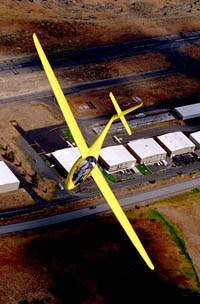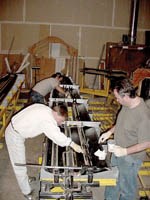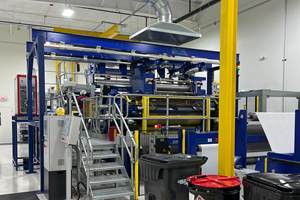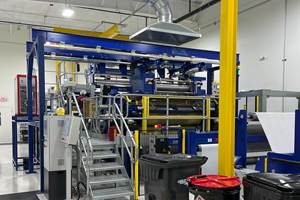SparrowHawk all-carbon composite sailplane
The first-ever all-carbon composite sailplane yields unprecedented maneuverability and top performance.
Sailplaning - unpowered flight - is an expensive pastime. There are several sailplane categories: Open, 15-meter, Standard and Ultralight. Large, high-performance Open-class sailplanes sport wingspans from 18m/59 ft to 30.5m/100 ft and a price of $100,000 to $200,000 (USD) or more. Smaller, more moderately priced sailplanes compete in the 15-meter class, limited to 15m/49-ft wingspans but with no other design restrictions. The Standard class, also limited to 15m wingspans, uses no performance-enhancing wing flaps. But the final category of sailplane, the Ultralight, is restricted not by wingspan, but by empty weight - to a maximum of 70 kg/155 lb. Ultralights are often dubbed "floaters" for their relatively slow speed and poor cross-country (i.e., straight-flight) performance. Standard-class sailplanes, by comparison, offer much better cross-country performance, but cost significantly more than Ultralight planes. They also may not maneuver as well in the air and are harder to manage on the ground because of both size and weight. Bridging these two classes, a new lightweight sailplane, the SparrowHawk from Windward Performance LLC (Bend, Ore., U.S.A.), is designed to meet Ultralight weight requirements and reduce sailplane cost into the bargain, while offering performance equivalent to or better than Standard-class sailplanes. The key to both performance and affordability, surprisingly, is carbon fiber.
For more than four decades, the vast majority of sailplanes (also called gliders) across all categories have been fabricated from a wet layup of fiberglass/epoxy. The SparrowHawk is the first sailplane with all-carbon composite wings and fuselage. It was created by general aviation veteran Greg Cole. Previously chief engineer of research and development at The Lancair Company Co., Cole helped design that company's Columbia 300 aircraft and the wing for the Legacy 2000. But his passion for soaring prompted Cole's formation, five years ago, of Windward Performance to design and build his own sailplane. He still maintains a business relationship with Lancair: all of the SparrowHawk's composite components are fabricated by Lancair employees in the company's Bend airport facility. Windward's team performs bonding, assembles the finished aircraft, and conducts testing operations in a nearby hangar.
The carbon structure's performance advantages over wet layup fiberglass were predictable, although achieving 15-meter performance with an Ultralight is notable no matter the material. But the real surprise was its affordability. With a base price of $33,950 (USD), the SparrowHawk is priced well under new 15-meter sailplanes, which cost from $50,000 to $70,000. Cole attributes both performance and affordability to the design freedom, design efficiency and fabrication streamlining that resulted from the use of carbon fiber.
"Smaller, lighter, smaller, lighter"
Looking first at conventional materials, including aluminum and fiberglass, Cole recognized that he could build a lighter sailplane with more advanced materials; and these more advanced materials afforded the craft aerodynamic advantages that allowed him to consider a shorter wingspan, a thinner wing profile and a significant overall weight reduction. "As the design went down this smaller/lighter spiral," he recalls, "it picked up all these benefits - handleability, fewer materials so less cost, the extra option of a parachute recovery system, and so on."
The most visible result of the all-carbon design is the 11m/36-ft wingspan, which appears stunted since the SparrowHawk's length of 6.3 m/20.6 ft is comparable to sailplanes with 15m wingspans. Under conventional thinking, Cole points out, gliders are being designed with longer wings to decrease induced drag. But longer wings demand more material for strength and stiffness, so planform and airfoil design are restricted by material and structural requirements. In the SparrowHawk, however, wing airfoils could be aerodynamically customized rather than structurally determined because "I don't have to make the wings overly thick to make them stiff enough," Cole explains. The wing chord (width from leading to trailing edge) is 20 percent smaller than the typical 15m wing chord. "The wings utilize five airfoils tailored to the local span requirements, minimum drag or maximum lift with soft stall at the correct Reynolds number."
The SparrowHawk's flying weight loads the wings at only 10 lb/ft of wingspan compared to more than 16 lb/ft in a typical 15-meter craft, making possible a smaller wetted area (the surface area of the plane that directly meets the air mass), which in turn decreases drag. Thus, it achieves the cross-country performance of many standard 15-meter sailplanes. But it exceeds their performance in climbing because the short, tailored wingspan and light weight of the SparrowHawk can exploit even the weak "microlift" of small thermals (columns of warm, rising air that sailplanes most commonly use to climb). The SparrowHawk's tight turning radius and good maneuverability increase the sailplane's ability to exploit the thermal core, resulting in better lift and longer "runs" between thermals. Overall, the plane is more immediately responsive to the pilot, which, Cole points out, makes it more enjoyable to fly. "You fly sailplanes because it's challenging mentally and it's fun physically," he says. "If the plane is responsive, it tightens up the loop of your input and the plane's response."
"A light, responsive sailplane like the SparrowHawk can effectively use scraps of lift that often punctuate difficult soaring environments," comments Gary Osoba, who piloted this glider to three world records, including two speed records and a triangular distance record.
Design efficiency
Cole knew that the exceptional performance of his carbon design could not necessitate a commensurately high price. "It has to be a great soaring machine; otherwise, it's no fun," he explains. "But extreme performance comes with extreme price, and we wanted to hold the price down." One means of accomplishing this end was to have most of the structural parts serve multiple functions. "If it's in the plane," Cole says, "it's probably doing two jobs - a stiffener and a redundant load path, for example." Bonded-in rein-forcements around the wing attachment fittings not only secure the wings but also are structurally tied into the cockpit seat, thus helping to distribute shear loads from the seat up into the wings. Similarly, the front bulkhead also serves as a lateral stabilizer for the crush zone and creates the plenum chamber for air circulation. Cole comments that most sailplane manufacturers do not attempt similar multiple-purpose designs because the process is challenging and laborious. "But if you do the work in design and tooling," he says, "then you get the benefits."
The cockpit closeout is especially efficient: Cole created a box structure that reinforces the opening around the canopy and also serves as ventilation ductwork. Molded into the closeout are the ventilation exits, the tow hook handle, the ballistic recovery system's firing handle (used to deploy the parachute) and the catch for the air brake handle. All of these pieces are made from carbon/epoxy, saving the weight of metal attachments, and the closeout transfers the loads from each attachment into the fuselage.
Savings also were realized because the smaller plane can use simpler systems than 15-meter planes without sacrificing aerodynamic performance. For instance, the SparrowHawk features fixed landing gear, carefully faired and integrated, instead of retractable landing gear. Also, since laminates in certain components are already at minimum thickness and core material would actually add weight, the SparrowHawk incorporates DIAB Inc. (DeSoto, Texas, U.S.A.) Divinycell HT foam core only where absolutely necessary. Core spans the entire length of the wings and horizontal tail, but the fuselage contains only some strategically placed core strips, and no core is found in any of the control surfaces.
Since labor costs correlate to surface area, the smaller plane also saves on labor. Additionally, unlike other sailplane classes, Ultralights do not require U.S. Federal Aviation Admin. (FAA) certification. Cole estimates that keeping the weight under the 70-kg/155-lb cutoff for ultralights may have saved Windward Performance as much as $1 million. Ironically, Cole designed the SparrowHawk for a certified material, which permitted him to reduce knockdown factors that account for the material uncertainty without sacrificing safety. The SparrowHawk is the first production aircraft to use Toray Composites America Inc.'s (Tacoma, Wash., U.S.A.) T700S prepreg, made from 12K plain-weave carbon fabric and Toray's 2510 epoxy resin system. This material comes with a certified materials database because Toray previously participated in the DOT/FAA/AR-00/47 qualification plan, also known as the AGATE (Advanced General Aviation Technology Experiment) methodology, from which this certification method arose (see "Agate Methodology Proves Its Worth,"HPC May 2003, p. 38).
Fabrication streamlining
For the unusual design to fully realize its potential, Cole also had to build an aerodynamically clean plane, with smooth, accurate surfaces that help minimize drag. He kept parts count low to minimize joints that could negatively affect airflow. Using the Toray prepreg helps ensure more consistent fiber volume and cleaner overlaps than wet layup would offer, says Cole. Parts are bonded with Loctite Aerospace (Bay Point, Calif., U.S.A.) Hysol 9394 adhesive. Bond gaps are minimized to keep strength up and adhesive weight low. Windward also uses the precise manufacturing techniques typically used for high-performance and commercial aircraft.
For the sake of precision and repeatability, Cole built and used his production tools for the very first SparrowHawk. The tools were fabricated from plugs with wet layup, with eight plies of carbon and two center layers of fiberglass, using resin systems from PTM&W Industries Inc. (Santa Fe Springs, Calif., U.S.A.) and Jeffco Products (San Diego, Calif., U.S.A.).
Soaring results
Structural loading on the first plane's fuselage and wings to 150 percent of design limits demonstrated the SparrowHawk's safety margins and air-worthiness. Flight tests checked handling, stall and spin behavior, aerodynamic control, and launch behavior, all with satisfying results. Consequently, later planes have used the same design, tooling and ply schedule as the first SparrowHawk. The first SparrowHawk took flight in 2001. To date, 12 planes have been completed, and Windward has orders through number 18. Cole plans to build a complete line of sailplanes in the SparrowHawk tradition, including a two-seat training plane and a self-launching glider, which includes a small motor for take-offs. He remains a believer in carbon composites. "Carbon frees up the design constraints," he says. "The materials allow the structure."
Related Content
Materials & Processes: Fabrication methods
There are numerous methods for fabricating composite components. Selection of a method for a particular part, therefore, will depend on the materials, the part design and end-use or application. Here's a guide to selection.
Read MorePark Aerospace launches aerospace, MRO structural film adhesive
Aeroadhere FAE-350-1 is a curing epoxy formulation designed for composite, metal, honeycomb and hybrid applications.
Read MoreScott Bader acquires Satyen Polymers, enhances commitment to Indian customers
Under the agreement, India-based Scott Bader Pvt. Ltd. will assume responsibilities for direct sales and marketing for all resin and gelcoat products, bring composites and adhesives to Indian market.
Read MoreEpoxy-based structural film adhesive intended for aerospace, MRO
CAMX 2023: Park Aerospace is presenting its new aerospace-grade film adhesive material Aeroadhere FAE-350-1, in addition to other product offerings intended for aerospace, defense and spacecraft.
Read MoreRead Next
Composites end markets: Energy (2024)
Composites are used widely in oil/gas, wind and other renewable energy applications. Despite market challenges, growth potential and innovation for composites continue.
Read MoreFrom the CW Archives: The tale of the thermoplastic cryotank
In 2006, guest columnist Bob Hartunian related the story of his efforts two decades prior, while at McDonnell Douglas, to develop a thermoplastic composite crytank for hydrogen storage. He learned a lot of lessons.
Read MoreCW’s 2024 Top Shops survey offers new approach to benchmarking
Respondents that complete the survey by April 30, 2024, have the chance to be recognized as an honoree.
Read More






















.jpg;maxWidth=300;quality=90)











